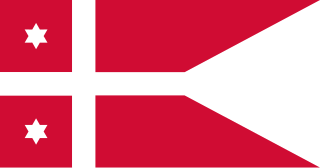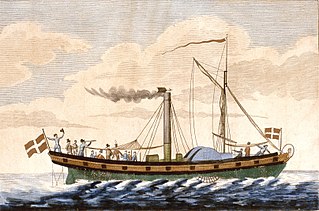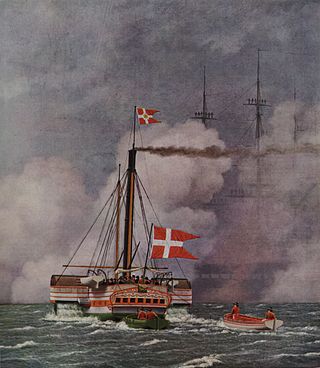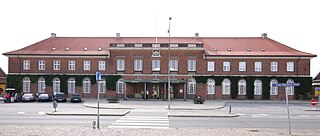
Transport in Denmark is developed and modern. The motorway network covers 1,111 km while the railway network totals 2,667 km of operational track. The Great Belt Fixed Link connecting the islands of Zealand and Funen and the New Little Belt Bridge connecting Funen and Jutland greatly improved the traffic flow across the country on both motorways and rail. The two largest airports of Copenhagen and Billund provide a variety of domestic and international connections, while ferries provide services to the Faroe Islands, Greenland, Iceland, Germany, Sweden, and Norway, as well as domestic routes servicing most Danish islands.
Higher education in Denmark is offered by a range of universities, university colleges, business academies and specialised institutions. The national higher education system is in accordance with the Bologna Process, with bachelor's degrees, master's degrees and doctoral degrees. The majority of higher education institutions are the responsibility of the Ministry of Higher Education and Science; however, some higher education institutions within the arts are the responsibility of the Ministry of Culture.

Fredericia is a town located in Fredericia Municipality in the southeastern part of the Jutland peninsula in Denmark. The city is part of the Triangle Region, which includes the neighbouring cities of Kolding and Vejle. It was founded in 1650 by Frederick III, after whom it was named.

The rail transport system in Denmark consists of 2,633 km of railway lines, of which the Copenhagen S-train network, the main line Helsingør-Copenhagen-Padborg, and the Lunderskov-Esbjerg line are electrified. Most traffic is passenger trains, although there is considerable transit goods traffic between Sweden and Germany.

Aalborg or Ålborg, is Denmark's fourth largest urban settlement with a population of 119,862 in the town proper and an urban population of 143,598. As of 1 July 2022, the Municipality of Aalborg had a population of 221,082, making it the third most populous in the country after the municipalities of Copenhagen and Aarhus. Eurostat and OECD have used a definition for the Metropolitan area of Aalborg, which includes all municipalities in the Province of North Jutland, with a total population of 594,323 as of 1 July 2022.
The Danish National School of Performing Arts is an artistic educational institution governed by the Danish Ministry of Culture. The school offers higher education and continuing education within performing arts. Based in Denmark, the school has campuses in Aarhus, Fredericia, Copenhagen and Odense.

Aarhus Central Station is the main railway station serving the city of Aarhus, Denmark. Serving as the main connecting hub for rail traffic between Aarhus and the rest of Denmark, the station is used by an average of 6.3 million people per year, making it the busiest station in Denmark outside the Copenhagen area. It is located in the city centre between the districts of Midtbyen and Frederiksbjerg with entrances from Banegårdspladsen and the shopping centre Bruun's Galleri, and with access to platforms from M.P. Bruuns Gade.
Royal Denship was a Danish multi-facility conglomerate ship and yacht builder. Presently in administration, the company has created some of the world's largest super yachts.

The first high-speed railway in Denmark was the Copenhagen–Ringsted Line, completed in late 2018 and opened in 2019. Further high-speed lines are currently under planning.

The 1928 Provinsmesterskabsturneringen i Fodbold was the 15th edition of the Danish provincial championship play-off, Provinsmesterskabsturneringen, the second highest senior cup competition, crowning the best provincial championship club of the five regional football associations outside the dominating Copenhagen football clubs, organised and financially supported by the national football organization Danish FA (DBU). This was the first edition of the tournament under its new status as a separate championship cup tournament, no longer being an essential part of the road to winning the Danish Football Championship, which it had been under the previous structure of Landsfodboldturneringen. The new Danish Football Championship structure, had its debut this season, 1927–28 Danmarksmesterskabsturneringen. Following a recommendation by the five provincial football associations, the Danish FA finally decided to re-establish a provincial football tournament in late March 1928.

The Chief of the Royal Danish Navy is the professional head of the Royal Danish Navy.

Caledonia was a paddle-wheel steamer, built in Scotland in 1815. The ship was bought by a Danish businessman in 1819 and it became the first steamship registered in Denmark. It spent most of its active years in Denmark operating between the cities of Copenhagen and Kiel. Broken up around 1843.

Kingston was a paddle-wheel steamer, built in England in 1821. The ship was bought by Danish owners in 1824 and became the first steamship on the route between Copenhagen and Lübeck. In Denmark her name was changed to Prindsesse Wilhelmine, in honour of Princess Vilhelmine Marie of Denmark, youngest daughter of king Frederick VI. In 1844 the ship became a three masted schooner and it was broken up around 1877.

The Western Regional Command was the overall command of all Royal Danish Army units in Jutland and on Funen. It was split into four military regions, and was responsible for the regional defence. In 1990, the Regional Commands were disbanded and control was collected at the newly created Army Operational Command.

Eagle was a paddle-wheel steamer, built in England in 1821. The ship was bought by the Royal Danish Navy in 1824 and became its first steamship. It was bought as a personal transport for the Royal Family of Denmark and got the name Kiel. Rebuilt as a two-masted schooner in 1853 and eventually broken up in 1897.
The 1926 JBUs Pokalturnering was the 3rd edition of the regional tournament, JBUs Pokalturnering, the highest senior cup competition organised by the Jutland FA (JBU). The tournament was held in the third and fourth quarter of 1926 with Aalborg BK as the defending cup champions. The season was launched on 22 August 1926 with the first round, embraced five cup rounds and concluded on 21 November 1926 with the cup final. A total of 29 clubs participated in the cup tournament, which was the same number of teams as the previous season.

Dandy was a paddle-wheel steamer, built in England in 1823. The ship was bought in 1825 by a Danish businessman and employed on the route between Copenhagen and Aarhus with the new name Jylland. The small steamer was not well suited for the job and in 1826 it was sent to Altona in Hamburg, where it got the name Dandy back and sailed between towns on the Elbe river. It was still present in the ship list from Altona in 1843, but by 1845 it was gone.

Mercurius was a paddle-wheel steamer, built in the United Kingdom in 1828. The ship was ordered by the Royal Danish Mail Service in Copenhagen and was employed on the postal and passenger service on the Great Belt between Korsør and Nyborg. In 1856 she was sold to Joseph Owen & Sønner in Copenhagen and in 1864 she was acquired by Oscar Petersen with the name Robert. Removed from the ship list in 1867.

Frederik den Sjette was a paddle-wheel steamer, built in 1830 for the merchant Lauritz Nicolai Hvidt of Copenhagen. She was the first steamship to be built in Denmark, with the notable exception of the steam engine, which was delivered from England. The vessel replaced the Caledonia on the route between Copenhagen and Kiel, and she had other routes as well. Sold in 1845 and foundered later that year. The ship was named in honour of the ruling king of Denmark and was also referred to as Frederik den Siette, Frederik VI and Frederik 6.

Horsens railway station is a railway station serving the town of Horsens in East Jutland, Denmark.


















